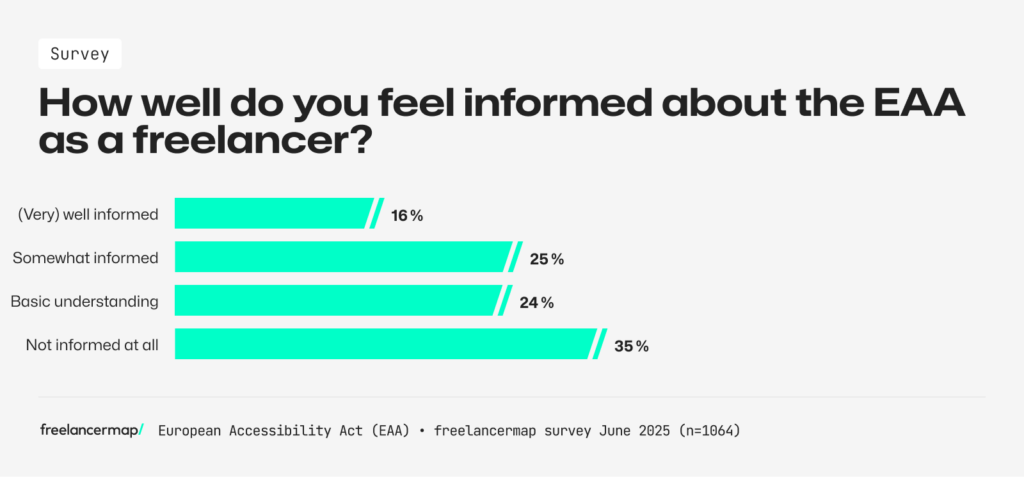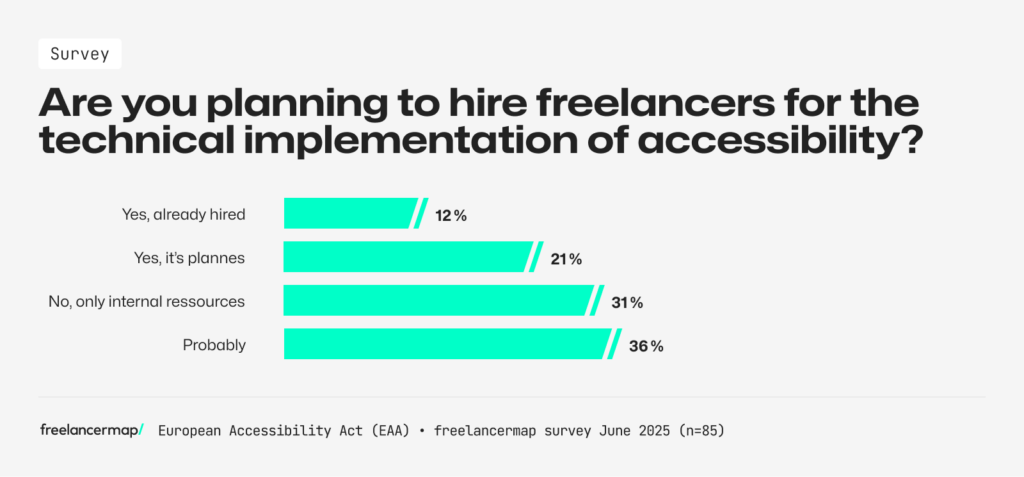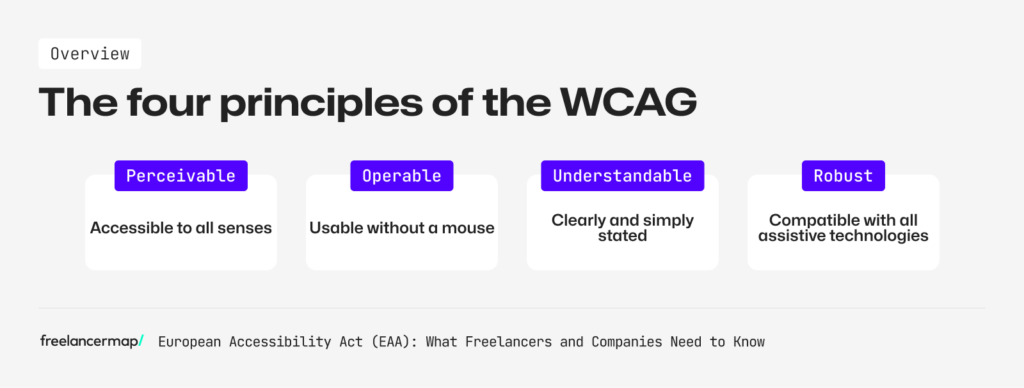The European Accessibility Act (EAA) marks a turning point in European legislation on digital accessibility. Starting June 28, 2025, many digital products and services must be designed to be accessible. What once applied primarily to public bodies now also affects private companies and self-employed individuals.
Instead of approaching the new law with uncertainty, it’s worth shifting your perspective: Accessibility drives innovation, opens up new target groups, and enhances the user experience.
We explain what you need to know about the EAA – from the legal foundations to practical implementation strategies.
Join our freelancer community today!
Create your profile in just 2 minutes and start attracting new clients.
What is the European Accessibility Act (EAA)?
The European Accessibility Act (EAA), formally known as Directive (EU) 2019/882, aims to ensure that people with disabilities have equal access to digital products and services across the European Union.
This directive is part of the EU’s broader commitment to an inclusive digital society and seeks to harmonize accessibility requirements across member states.

The EAA pursues four core objectives
The core objectives of the EAA are:
- Strengthening inclusion: People with disabilities should be able to participate fully in digital life
- Harmonization: Creation of uniform standards throughout the European Union
- Legal certainty: Clear rules for companies and better protection for consumers
- Promote innovation: Create incentives for accessible product development
freelancermap survey: information status and preparation
Our recent survey of over 1,000 freelancers and 85 companies clearly shows: Accessibility is no longer a niche topic. However, there is still a significant need for information and action, especially among freelancers.

The numbers speak for themselves:
- 34.5% of freelancers surveyed said they have not yet been informed about the EAA
- and another 25% feel only partially informed.
Meanwhile, the company survey reveals that:
- 41.2% of companies have not yet started implementing the law,
- nearly one-third are planning concrete measures,
- and 34.1% are already actively working on implementation.
This discrepancy offers opportunities for both sides: While companies increasingly need support in implementation, freelancers with the relevant expertise can represent a valuable resource.
Practical experience and expertise: Need to catch up
The lack of preparation is also reflected in practical experience: Almost two-thirds of freelancers have no experience with accessible projects. The Web Content Accessibility Guidelines (WCAG), which serve as the technical basis for the implementation of the EAA, are completely unknown to 58.6% of respondents.
It’s already clear that two out of three companies plan to use external support for implementation. Some have concrete projects with freelancers in preparation, and one in eight companies (12.9%) has already commissioned them. So the demand is there – the qualifications just need to catch up.

Relevant areas of application: Where action is needed
The freelancer survey identifies specific areas where changes are expected:
- 28.6% expect changes in projects for affected customers
- 24.8% see impacts on apps with e-commerce functionality
- 18.5% expect changes in online shops and booking platforms
- 15.6% name commercial e-books and media content as an affected area
These assessments are consistent with the scope of the law: The EAA primarily affects digital offerings with a commercial orientation, including websites, online shops, and digital services for end consumers.
Challenges and support needs: Two perspectives
Freelancers see the greatest challenges as a lack of knowledge (41.3%) and increased time and costs (39.2%). Companies also need support: 15.3% would like industry specific checklists, 12.9% a basic overview, and 11.8% legal advice. It’s also noteworthy that 10.6% of companies explicitly seek contacts with experts and freelancers.
The need for support on the freelancer side is similarly specific: Almost a third would like a basic overview of the topic, and 31.5% need checklists for projects. These overlaps demonstrate that both sides can benefit from each other.
Recognizing and utilizing potential: Working together towards success
The survey results clearly show: The EAA offers opportunities for both sides.
While 21.1% of freelancers see new project opportunities in consulting, implementation, and audits, and 17.6% recognize a new specialization opportunity, companies are actively seeking qualified partners for implementation.
Despite this obvious market opportunity, only 8.1% of freelancers surveyed plan to specialize in accessibility – an indication of the untapped potential in this area.
In order to turn possibilities into concrete steps, the question arises as to who exactly is affected by the EAA and what requirements arise from it.
Who is specifically affected by the EAA?
The good news first: Micro-enterprises, i.e., companies with fewer than 10 employees and an annual turnover of less than 2 million euros, are generally exempt, provided they do not offer special barrier-free products or services for people with disabilities.
Directly affected are:
- Providers of e-commerce, online bookings, or payment platforms
- Developers of apps with sales or media functions
- Producers of audiovisual content (e.g., video platforms or podcasts)
- Digital publishers (e.g., e-book providers)
Freelancers and agencies working on behalf of affected companies are indirectly affected. This means that accessibility is often part of client projects, even if the freelancers themselves are not formally obligated.
Technical basis: What does accessibility actually mean?
The law is based on the WCAG 2.1 guidelines at Level AA, an internationally recognized standard for accessible digital content. WCAG is based on four principles:
#1 Perceivable: Content must be perceptible to all senses, for example, through alt text for images or subtitles for videos. Many alternative texts for images, such as “Image2” or “logo_neu.png,” are meaningless; others are far too long or missing altogether.
#2 Operable: All functions must be usable without a mouse, for example, via keyboard or voice commands. Dropdown menus and carousels are often only operable with a mouse, which presents a challenge for people with mobility impairments.
#3 Understandable: Content and navigation should be clear and predictable and written in simple language.
#4 Robust: Content should be compatible with different technologies and tools, such as screen readers.

Technically, many of the principles are easy to resolve and implement. The problem in this case is often a lack of expertise and inadequate prioritization. As a result, the EAA is easily forgotten in everyday business. The true potential of accessible offerings is often underestimated: They not only improve access for a select few but also open up new customer groups that have previously been unconsciously excluded and not reached by traditional marketing.
What falls under the EAA?
The European Accessibility Act (EAA) affects a number of digital products and services:
- Websites and mobile apps with commercial features
- Self-service terminals (e.g., ticket and ATM machines)
- E-book platforms and reading devices
- Streaming and media library services
- Digital payment services and online shops
Products placed on the market before June 28, 2025, do not need to be subsequently adapted unless they are substantially modified or updated.
Accessibility for freelancers: New expectations and new opportunities
Even though many freelancers aren’t directly affected, they’re increasingly being commissioned to implement accessible solutions. Those familiar with accessibility standards gain a valuable market advantage.
Two out of three companies plan to use external support for implementation.
Am I affected as a freelancer?
Legally, the EAA does not apply to most freelancers, especially if they operate as solopreneurs or micro-enterprises without their own e-commerce services. However, there are two important exceptions:
- Freelancers with their own e-commerce apps, online shops, or commercial media offerings are directly affected.
- Indirectly affected are, for example, web designers, developers, UX/UI experts, content creators, and media producers who work for affected customers.
New skills for freelancers in the area of career freedom
Accessible design requirements are increasingly becoming part of briefings and project tenders. Freelancers who are prepared for this have a clear competitive advantage.
Looking for new opportunities in accessible design?
Browse the latest openings
The EAA means an expansion of the required skills for solo self-employed individuals. Those working in this field should develop and regularly refine specific skills:
- Understanding and correctly applying WCAG 2.1 Level AA
- Accessible design: Implementing color contrasts, font sizes, and navigation correctly
- Using semantic HTML & ARIA roles correctly
- Implement and test keyboard navigation
- Ensure screen reader compatibility (e.g., with NVDA or VoiceOver)
- Integrate automated testing with tools like axe or Pa11
Accessibility as a specialization: A growth niche
The demand for accessibility expertise is increasing, and new professional roles for freelancers are emerging:
- Accessibility Consultant provides strategic consulting for companies
- Accessibility QA Tester is responsible for the quality assurance of digital products
- Remediation specialist subsequently optimizes existing systems
- Trainer trains customers, their employees, and agencies
Looking for accessibility experts?
Browse the latest freelance profiles
Contract clarity & protection for freelancers
For accessibility projects, freelancers should adapt their contracts:
Define performance: For new projects, define exactly what falls under barrier-free implementation.
Communicate compensation: Clearly state additional costs for accessibility testing and additional effort.
Exclusion of liability: Exclusion of liability for third-party content, as well as subsequent changes by the customer himself.
Establish standards: The Web Content Accessibility Guidelines have different levels: A, AA, and AAA. Which should apply to your project?
Example clause for a freelancer contract: “Accessibility according to WCAG 2.1 at Level AA is only part of the service if this is explicitly agreed in the offer and remunerated accordingly.”
Further training & certifications for freelancers
There are a number of continuing education courses and certificates available for freelancers that can provide an advantage when awarding new project tenders in this field.
The International Association of Accessibility Professionals (IAAP) offers various certificates that are recognized worldwide:
- CPACC: Basics of Accessibility
- WAS: Technical Certificate for Developers
- CPWA: Combination of both for skilled workers
Step-by-step guide: How freelancers integrate accessibility into their projects
Digital accessibility doesn’t require freelancers to completely rethink their approach, but it does require conscious planning, testing, and documentation of completed tasks. A structured approach helps solo freelancers efficiently incorporate accessibility requirements into their projects.
Inventory & analysis
Inventory:
At the beginning of a project, it is necessary to take stock of all digital components and prioritize them based on reach and user relevance.
Initial assessment & analysis:
Conduct automated tests (e.g., with axe or WAVE) and analyze key details such as the semantics of the HTML and the use of keyboard navigation.
Planning & strategy development
Set accessibility goals:
The next step is to define specific goals, such as which WCAG level should be achieved. It is also important to determine which areas need to be prioritized and whether there are any legal requirements from the client.
Define tasks & timeframe:
Freelancers should plan for approximately 20 to 30% additional effort within the project timeline. Dedicated testing phases, such as after a website redesign, are helpful.
Implementation & testing
Design & development:
Use semantic HTML, ensure sufficient color contrast, implement keyboard navigation & screen reader compatibility, and apply ARIA attributes selectively.
Testing:
Use tools like axe DevTools or Pa11y for automated testing. In addition, manual tests help determine whether, for example, tab navigation covers all elements or error messages are displayed clearly.
Documentation & communication
Accessibility documentation:
Freelancers should document which tools and methods were used for testing, the level of WCAG compliance achieved, and any remaining tasks or limitations. A legally recommended component is the so-called “Accessibility Statement,” which the freelancer can create for the website.
Client communication:
Freelancers should clearly explain to clients which accessibility requirements have been implemented and where there may be ongoing maintenance needs. This could potentially lead to follow-up work, such as further optimizations, employee training, or periodic accessibility checks.
| Project phase | Accessibility integration |
| Design | Checklist with contrast, scalability & structure |
| Development | CI/CD with automated tests |
| Testing | Manual screen reader checks & keyboard tests |
| Handover | Documentation & recommendations for the customer |
Immediate measures for companies
- Check impact: Analyze whether and to what extent the company is affected by the BFSG
- Assess the status quo: Conduct a professional accessibility audit
- Develop a strategy: Create a concrete implementation plan with a timeline and budget
- Build a team: Appoint responsible persons, engage external experts, and train your own employees
- Implement quick wins: Start with easy-to-implement improvements
Long-term planning
- Holistic approach: Understanding accessibility as an integral part of all business processes
- Continuous improvement: Regular review and optimization of measures with the help of external experts
- Stakeholder engagement: Actively involving people with disabilities in development processes
- Promoting innovation: Using accessibility as an innovation driver and competitive advantage
Enforcement & control
Monitoring compliance with the regulations rests with the respective state market surveillance authorities. They identify violations and can impose sanctions. Consumers (and competitors) can report violations if they believe, for example, that a product or service is not accessible.
In the event of a violation, the market surveillance authority may order the recall of the affected product or service and impose fines of up to 100,000 euros.
Conclusion
The European Accessibility Act (EAA) represents a significant step toward a more inclusive digital society. It presents both challenges and opportunities for freelancers and companies. A strategic approach to these requirements is crucial for successful implementation.
The EAA is more than just a regulatory requirement – it’s an opportunity to make digital offerings accessible and usable for everyone.
Freelancers who take the European Accessibility Act (EAA) seriously not only gain technical expertise but also position themselves as valuable partners for companies seeking to invest in an inclusive future.
Companies that strategically address this opportunity and accessibility not only fulfill the legal requirements; they also establish a sustainable and competitive position for themselves in an increasingly inclusive market.
With the right strategy, the right tools, and the necessary commitment, EAA compliance becomes a success factor for solo self-employed individuals and companies.
FAQs about the EAA
Does the EAA also affect my small business?
This depends on your company size and the products/services you offer. Micro-enterprises with fewer than 10 employees and an annual turnover of less than €2 million are generally exempt, unless they offer specifically mentioned services such as e-commerce.
Do I have to completely redevelop existing websites?
Not necessarily. Existing websites can often be made BFSG-compliant through targeted adjustments. A professional analysis will reveal which measures are necessary.
How do I know if my website is already accessible?
Use automated tools like axe or WAVE for an initial assessment. However, a full evaluation requires professional testing with manual testing.
Which WCAG version is relevant?
The EAA is based on WCAG 2.1 Level AA. WCAG 2.2 and 3.0 are not yet mandatory, but can already be implemented as best practices.
Are automated tests sufficient?
No, automated testing only covers about 30-40% of all accessibility issues. Manual testing and user testing with people with disabilities are essential.
How often do I need to test?
Accessibility testing should be conducted with every major update or change, and a comprehensive audit should be conducted at least once a year.
Who monitors compliance with the EAA?
The federal states’ market surveillance authorities are responsible for monitoring. Consumer protection organizations and affected individuals can also report violations.
Can I be sued if my website is not accessible?
Yes, that’s possible. In addition to fines under the EAA, civil law claims may also exist, particularly under the General Equal Treatment Act (AGG).
Are there transition periods?
The EAA will apply to new products and services from June 28, 2025, without any transitional periods. Longer deadlines apply to existing services.
